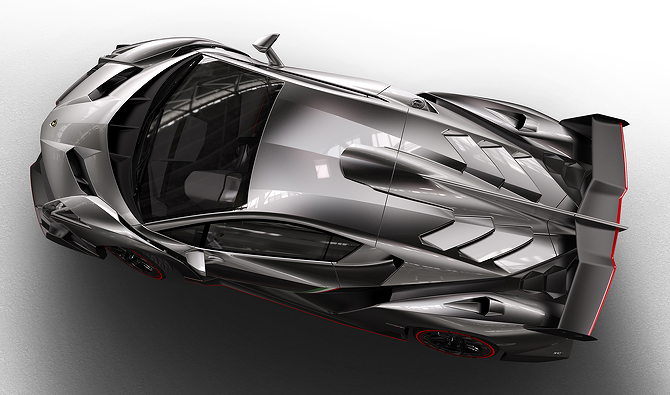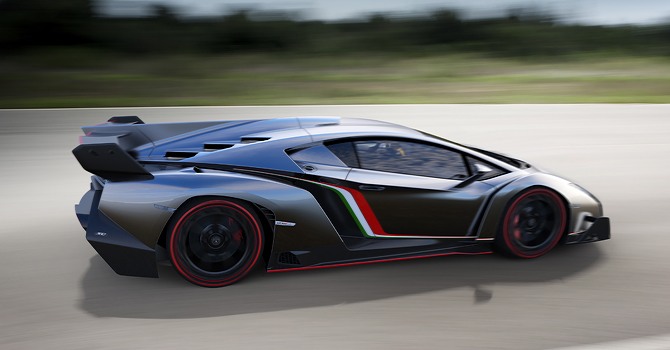
Lamborghini Veneno – Debut at the Geneva Motor Show
Lamborghini Veneno
Published by Autobahn Buzz (Lamborghini Veneno)
In the year of its 50th anniversary, Automobili Lamborghini premiered an incredibly exclusive design at the Geneva Motor Show in April 2013. Only three distinct iterations of the Lamborghini Veneno will be created and offered. Its layout is consistently focused on optimum aerodynamics and cornering stability, giving the Veneno the genuine dynamic embodiment of a racing prototype, yet it is totally homologated for the road. With a maximum output of 552 kW / 750 hp, the Veneno accelerates from 0 to 100 km/h in merely 2.8 seconds, and the top speed for this street-legal racing car stands at 355 km/h. It is valued at three million Euros plus tax– and all three supercars have actually already been sold to customers.

The Lamborghini Veneno features a twelve-cylinder engine with a displacement of 6.5 liters and an incredibly fast-shifting 7-speed ISR transmission. The state-of-the-automotive art and engineering chassis and steering system offers five steering modes and has permanent all-wheel drive. This full tilt racing chassis is equipped with pushrod suspension and horizontal springs/dampers. Most of all, the Veneno underwent a unique manufacturing experience that Automobili Lamborghini possesses in the development and implementation of carbon-fiber materials. The complete framework is generated as a CFRP monocoque, as is the external skin of this extreme sports car. The interior as well features innovative, Lamborghini-patented manufacturing processes, including forgings, in addition the use of composites and CarbonSkin.

Totally in keeping with the practice of the brand name, the name of the Veneno originates from a fabulous fighting bull. Veneno is the name of the strongest and most assertive fighting bulls on earth. In the romantic history of bullfighting a famous bull named God is likewise renowned for being one of the fastest bulls in bullfighting. His name became well-liked in 1914, when he fatally injured the famous torero José Sánchez Rodríguez throughout the bullfight in the arena Sanlúcar de Barrameda’s, Andalusia, Spain.
Special Notes of the Design:
The Lamborghini Veneno delivers the aerodynamic efficiency of an auto racing model for the road. Every single component of its design pursues a clear function — exceptional dynamics, optimum downforce with minimal drag and excellent cooling of the high-performance engine. Yet the Veneno is clearly a Lamborghini; it sticks solidly to the consistent layout philosophy of all the extremely exotic sports autos from Sant’Agata Bolognese. The Veneno offers extreme proportions – as the powerfully arrow-shaped front end and the interplay between razor-sharp lines and specific surface areas conveys in the sculpted form of the body.
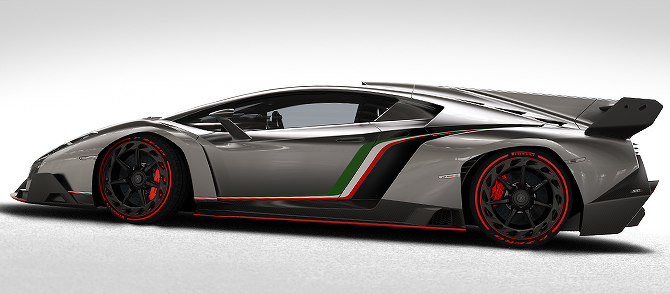
The entire front end of the Lamborghini Veneno has been elongated for excellent airflow and downforce. The front end works as a large aerodynamic wing. Large channels direct the air to the electrical outlets in the front hood and in front of the windshield and also to the front wheels. Distinct Lamborghini signature characteristics on the Veneno include the Y shape of the angular headlamps that reach well into the fenders as well as the scissor doors.

The branch of the fenders from the car body recalls the world of sport prototypes that race at Le Mans and in ALMS and at the same time optimizes the aerodynamic flow. The side line of the Veneno is for that reason dominated by enormous sills and the mighty tire arches rear and front. Listed here, too, sophisticated aerodynamics guarantee perfect airflow to the large openings for engine cooling and the intake of air.
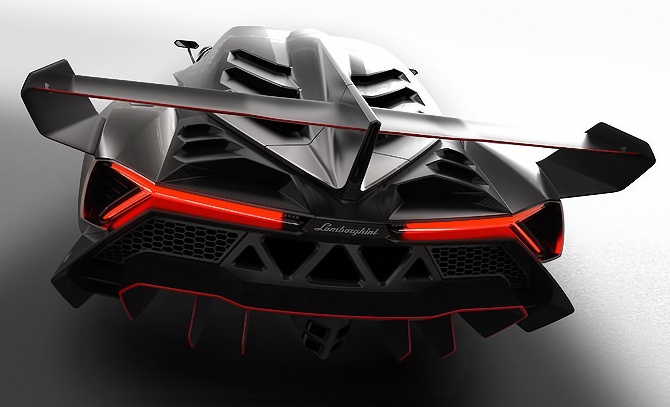
Similar to the front end, the rear of the Veneno has also been optimized for underbody aerodynamics and broadband cornering stability. The hassle-free underbody transitions into a substantial diffuser framing the four sizable exhaust pipes broken down by a splitter to boost the degree of peak downforce. Big openings offer to aerate the engine bay and manage the airflow to the rear wing, with the only sealed area at the rear being reserved for the license plate. The rear lights, consisting of brake lights, indicator lights and fog lights, pick up the Y theme too. The engine cover has six wedge-shaped openings, with the function of the bottom opening focused on optimum dissipation of heat from the engine. The engine cover extends into a sizable main “shark” fin, which enhances performance throughout braking and rear-end stability, by providing additional downforce at high yaw angles and for this reason raising the high-speed cornering performance.
The changeable rear wing’s creation was directly learned from motorsport participation and considerable aerodynamic simulation to get the most effective efficiency of rear wing
interaction with rear diffuser air flow.
The special alloy wheels are 20 inches at the front and 21 inches at the rear and are furnished with center mountings. Their design is also established by aerodynamic functionality– a carbon-fiber ring around the wheel rim functions like a wind turbine to deliver additional cooling air to the carbon-ceramic brake discs.
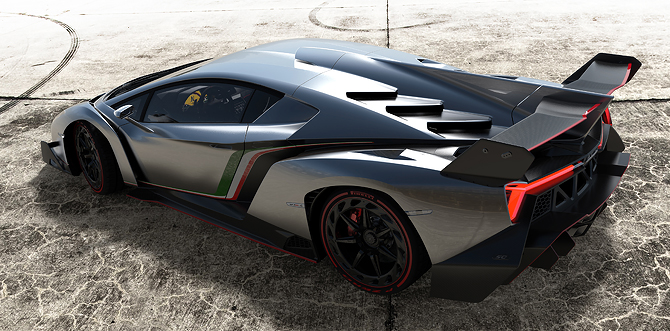
The Veneno is repainted in an all-new, gray metallic-look shade with specific parts shining in the black of the noticeable carbon-fiber structure. The only auto to screen all three colors of the Italian flag as an accent is the vehicle shown at Geneva. This Veneno will remain the property of Lamborghini. The three autos sold to consumers each feature a solitary shade of the Italian national flag, with each other a triology in green, white and red accents and thus representing each an unique piece.
Special Notes of the Technology:
The Veneno is more evidence of Automobili Lamborghini’s one-of-a-kind proficiency in CFRP-based light-weight layout. A monocoque made from carbon-fiber with improved polymer types signifies the basis of the Veneno. It is largely the same as the Aventador monocoque– as are the aluminum sub-frames in the rear and front.
Its type has actually been adapted to the new creation. All exterior parts are made from CFRP. The Veneno meets all protection and registration requirements worldwide, and likewise includes a full complement of safety systems, from airbags to the adjusted ESP.
Carbon fiber dominates the interior of the Veneno, also. The carbon fiber monocoque becomes apparent inside the vehicle in the location of the central tunnel and the sills. The two lightweight bucket seats are made from Lamborghini’s trademarked Forged Composite. The woven carbon-fiber CarbonSkin is utilized to be within the entire cockpit, including the seats and the headliner. This special material is soaked in a very unique type of resin that supports the fiber structure, while enabling the material to remain supple. Like a hi-tech fabric, this very fine-looking carbon-fiber matting matches completely to any type of form, and it lowers weight.
The racing pedigree has actually been transferred to the instrument panel. It has been completely redesigned and now, thanks to an aggressive graphics and to the intro of some additional attributes like the G-meter, which provides all the vital details to the motorist for confident command of the vehicle.
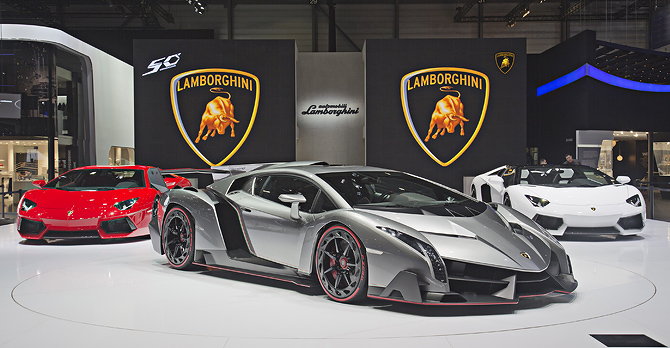
The step-by-step, carbon-fiber, light-weight development of the Veneno is not only visible, it is also noticeable on the weight scales: With a dry weight of merely 1,450 kilograms (3,190 pounds), the Veneno is also 125 kilos (275 pounds) lighter compared to the currently extremely lean Aventador. The beneficial power-to-weight ratio of 1.93 kg/hp (4,25 lbs/hp) guarantees a performance that is absolutely nothing but mind-blowing. Even the stunning acceleration figure of 2.8 secs could not effectively explain it. Regardless of a wind resistant arrangement configured for extreme downforce, the Veneno has extremely low wind resistance which allows it to get to a top speed of 355 km/h (221 miles per hour).
The twelve-cylinder with a displacement of 6.5 liters is a thrilling mix of absolute high-revving frenzy and phenomenal pulling power. Its outcome has been increased to 552 / 750 hp, facilitated with enlarged intake paths, optimized thermodynamics, a slightly greater ranked revoltions per minute and an exhaust system with decreased back pressure. The ISR manual gearbox, permanent all-wheel drive and pushrod suspension have actually all been particularly adapted to meet the needs of the Veneno.
The Lamborghini Veneno celebrates its initial public appearance at the 2013 Geneva Motor Show. The auto on show is the variety 0, the Lamborghini test auto. Its future has actually not been figured out yet, but it will permit Lamborghini to accomplish its task of testing and discovery, both while driving and on the race track. The triumvirate constructed from three special cars will be created throughout the year 2013 and handed over to their future owners.

